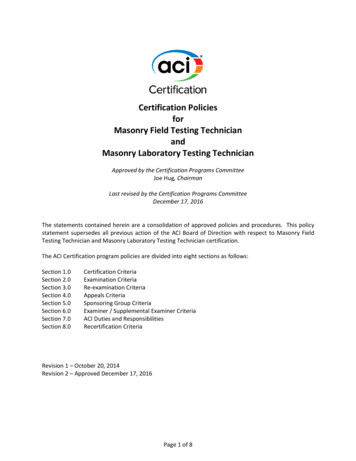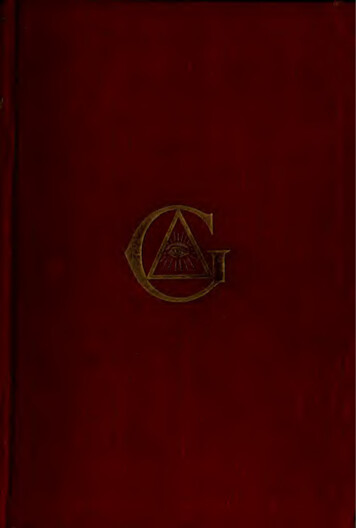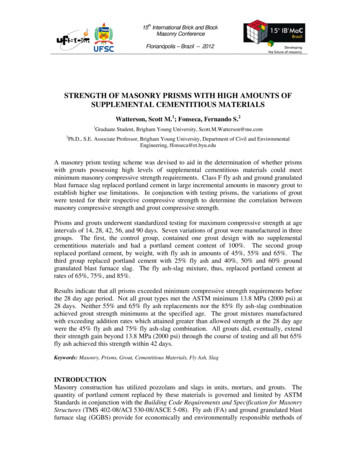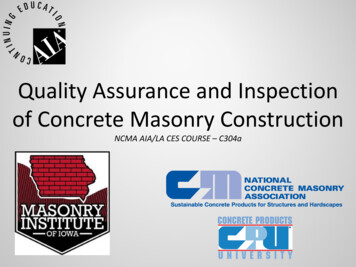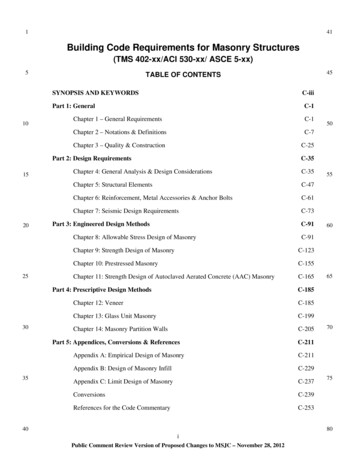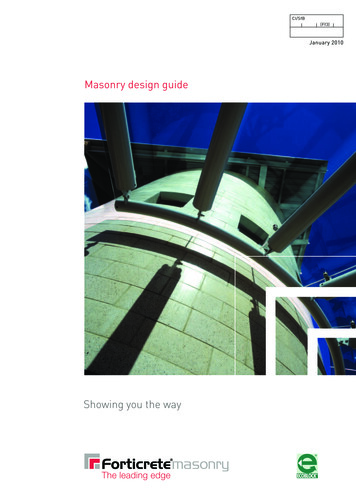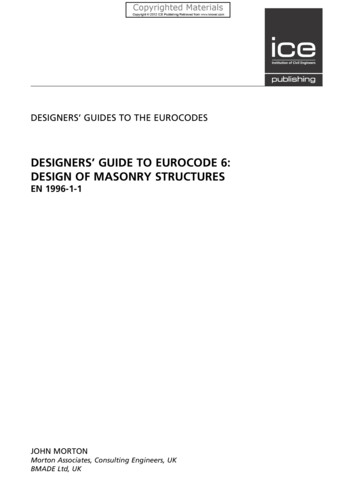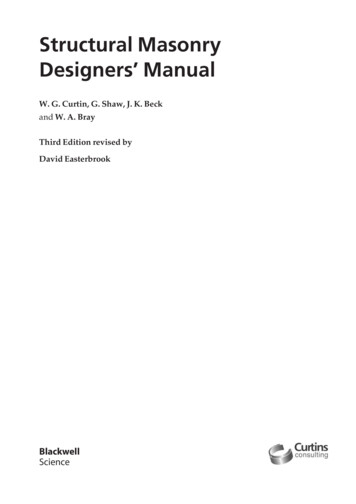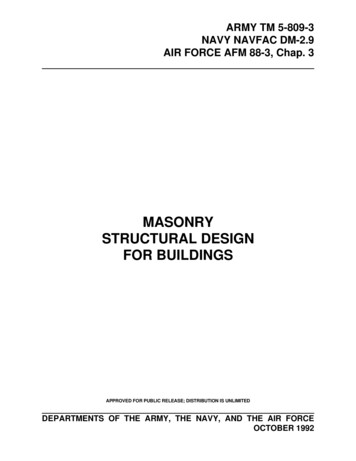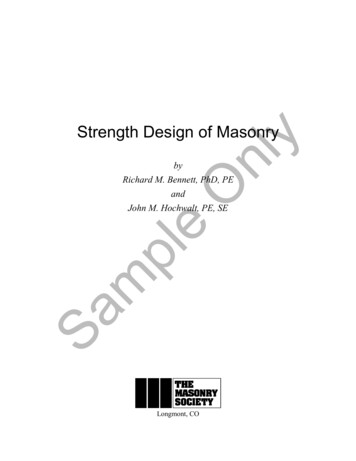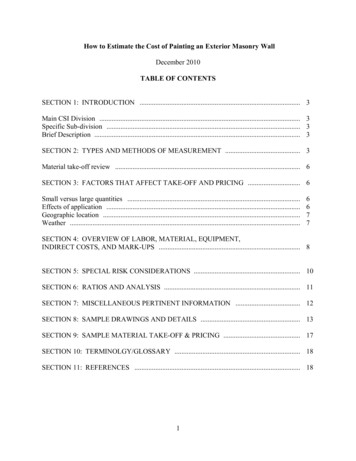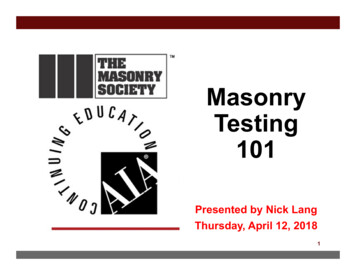
Transcription
MasonryTesting101Presented by Nick LangThursday, April 12, 20181
Course Description Proper testing of masonry products is essential toensure that materials meet project requirements. Thereare many mistakes that can be made during producttesting, and most of these mistakes can lead to jobsbeing delayed or stopped, and usually require costlyfollow-up to determine if there are problems with theresulting construction. Proper testing procedures formasonry products will be covered here, and typicalmistakes made will also be presented.7
Learning Objectives Understand the common tests required by the buildingcode for testing of masonry units, materials andassemblies. Understand the proper procedures for performingtesting of masonry materials according to ASTMstandards. Learn the requirements for masonry material testingequipment according to ASTM standards. Identify common errors that occur during testing andhow to correct them.8
Why Inspect/Test Masonry? Code requirements Structural design requirements Quality control, quality assurance Workmanship Aesthetics Economy
The Need for QA and QC Higher quality and better masonryperformance Increased confidence that the project willbe constructed correctly and as designed Confidence in design reduces overdesign More cost efficient10
QA vs. QCWhat is the difference? Quality Assurance (QA): the owner’s ordesigner’s efforts to determine projectacceptability, accomplished through testing,field inspection, and QC Quality Control (QC): contractor’s ormanufacturer’s efforts to ensure the finalproperties of the product in effort to achieve aspecified goal11
What Do We Test for roportionsClay brick No NoConcrete block No NoMortar No Grout No Prisms NoNoNo
CONCRETE MASONRY UNITSSAMPLING AND TESTING
Concrete Masonry Units ASTM C140, Standard Test Methods for Samplingand Testing Concrete Masonry Units and RelatedUnits Used to determine compressive strength, waterabsorption, density, and dimensions of CMU Most common test performed on CMU
Dimensional Measurements Overall width measurements are taken at mid-lengthacross top and bottom bearing surfaces Overall height measurements are taken at mid-lengthacross each face Overall length measurements are taken at mid-heightacross each face
Dimensional Measurements Face Shell and Web thickness are taken ½ inchdown from the top surface as made (bottomsurface as laid) Record minimum thickness of each element NEW – also measure web height
Web Height Measure and record the minimum height of each web.Slide 3-17
Absorption Testing Four required weighings: Received weight Immersed weight Saturated weight Oven-dry weight Need to be in that order
Absorption Testing These four weights allow for calculation of manyproperties: Absorption/Moisture Content Density Average Net Area Net Volume Equivalent ThicknessMore on thissoon!
Compressive Strength Compressive strength specimens must be capped(gypsum or sulfur) – Practice C1552 Pad caps not currently allowed!
Compressive Strength Align centroid of test specimen with center of thrust ofmachine Apply ½ of expected load at any convenient rate Apply second half in 1 to 2 minutes to failure
Testing Machine Thickness of bearing plate is important Too small and plate will bend – lowering compressivestrength
Testing Machine Plate shall be at least equal to the distance fromedge of from the edge of the spherical head to themost distant corner of the specimenThickness d
Calculating Strength A hollow CMU has both a net area and a gross area Gross area is simply length x width Net area is measure of solid area of concrete in theplane of bearing area of CMU (determined throughabsorption testing) Compression and absorption units must be identical Cannot test compression on units tested for absorption ASTM C90 minimum strength is net areacompressive strength
Gross vs. Net AreaGross AreaNet Area25
Moisture Content CMU for compression testing must be in ‘equilibrium’with environment Not too wet, not too dry Defined as moisture content after 48 hours in lab air 75 15 F and RH 80%26
Masonry Mortar Masonry mortar is used to: Bond units together; Accommodate unit irregularities; Provide weather barrier; and Enhance aesthetic finish.27
Masonry Mortar ASTM C270 Specifying mortar Laboratory testing ASTM C780 Preconstruction testing Construction Evaluation Evaluating mortarconsistency duringconstruction ASTM C1586 Practical guide for mortartesting
Specifying Masonry Mortar Masonry mortars are specified to meeteither the proportion or propertyrequirements of ASTM C270.Proportion Specification--OR-Property SpecificationIt makes no sense tospecify both.If neither isspecified, theproportionspecificationgoverns.
C270 Proportion Specification
C270 Property SpecificationThese properties should not be applied to field sampledmortarASTM does not specify minimum physical requirements forfield mortar
ASTM C780 – Field Evaluation Used to determine compliance withspecified proportions Also used for quality control anduniformity For most methods, the absolute values areless important that variation betweenresults Preconstruction testing is crucial ASTM C270 Table 2 should not be usedto evaluate field sampled mortars! NO FIELD REQUIREMENTS FORMORTAR STRENGTH
Differences in TestingASTM C270ASTM C780Mixer UsedHobart 5 qt bench topField MixerSand ConditionOven-dryMoisture as isConsistencyMixed to specified flow(stiffer than fieldapplications)Mixed to workable fieldconsistencyCompression SpecimensCubes onlyCubes or Cylinders
ASTM C780 Multiple Test Methods Consistency by Cone Penetrometer Consistency Retention Mortar Aggregate Ratio Air Content Compressive Strength Mortar-Aggregate Ratio Testing best way to evaluateproper mortar proportions
ASTM C780 Mortar:Aggregate Ratio Can determine ratio ofcementitious materials toaggregate used Limits: Provides ratio by weightCannot separate multiplecementitious materials
Mortar-Aggregate Ratio Sampling Before going to jobsite: Add 250 mL isopropyl alcohol (91% preferred) to each of twomortar sample containers Seal each and weigh, record to the nearest 1 g At jobsite Take mortar samples directly from mixer (batch sampling) Place 500 – 700 g of mortar in each container Shake VIGOROUSLY!!! Obtain sand sample (at least 500 g) and place in sand container
ASTM C780,Mortar-Aggregate RatioJar 1Jar 2Jar 3Mortar Alcohol Sand
Mortar-Aggregate RatioSampling Why Alcohol? Isopropyl alcohol stops the hydration reaction for cementand water Keeps the cement from hardening but not forever Suggested to get samples back to the lab and completetesting within 24 hours (but sooner is always better)
Mortar-Aggregate RatioTesting Back at the Lab Weigh each mortar container separately and record Then .
Mortar-Agg Ratio, Jar 1 Pour Jar 1 intoNo. 100 sieve. Option – useprotectionsieveRinse to pass allfine materialthrough.Oven-dry, weigh,and record theremainingmaterial
Mortar-Agg Ratio, Jar 2 Pour mortar and alcoholinto pan Use water or alcoholto transfer Ignite to burn off thealcohol. Place pan in oven. Oven-dry, weigh andrecord weight ofremaining residue
Mortar-Agg Ratio, Sand Weigh sand as receivedOven-dry, weigh, andrecord weight of sandfrom Jar 3.Pour dry sand intoNo.100 sieve and wetsieve to pass throughfine particles.(protection sieve)Oven-dry, weigh, andrecord weigh ofretained material todetermine percent offine aggregate.
Grout for MasonryConstructionTesting per ASTM C1019
Masonry Grout Masonry grout is a veryfluid concrete placedwithin the cells of themasonry units to bondthe reinforcement, units,and mortar into a singlecomposite assembly.44
ASTM C1019 – Test MethodCompressive Strength of Grout
Specimen Forming ‘Standard’ forming method is pinwheel using unitsfrom construction Other methods of forming grout specimens areavailable, and can be used These methods, however, must be correlated to“pinwheel” method– Correlation limited to grout design, units used, andmethod of forming– Developed by comparative testing (10 pairs)– Coefficient of variation for other forming methods mustnot be greater than pinwheel
Preparing Grout CompressiveStrength Specimens
Mold Construction Select a level location wherethe molds can remainundisturbed for up to 48 hours Construct the mold space toreplicate the grout location inthe wall. If the grout isplaced between two differenttypes of masonry units, bothtypes should be used toconstruct the mold
Grout Molds Square cross-section of 3 in.minimum Permeable liner materialpaper (no plastic, buildingwrap, building felt) Twice as high as its width Nonabsorbent block at base Face in contact with grout notpreviously used to moldspecimen
Alternate Grout Specimens Must be approved by the specifier Approval is based on comparative testing COV of alternate method cannot be greater than standardmethod Limited to a single shape and size, a single formingmethod, a single grout mix, and a single masonry unitGrouted cellGroutDTHCMU withgrouted cellsGrout sample sawcut from groutedcell h/t 2HGrout samplecored fromgrouted cell h/t 2
Measuring Dimensions Measure width and length of specimens Width is measured on each face of specimen atmid-height Calculate cross-sectional area by averaging thewidth of opposite faces, then multiplying the twoW2averages A ((W1 W3)/2) * ((W2 W4)/2) Length is measured on each face at mid-width Amount out of plumb is measured at mid-widthof each faceW1Top ofspecimenW3W4
Calculations Determine compressive strength by dividingmaximum load by net cross-sectional area For alternative methods of forming: Calculate average corrected compressive strength bydividing maximum load by cross-sectional area, and thenmultiplying the result by the conversion factor Conversion factor for alternative methods specific tospecimen shape, method of forming, masonry unitsused, and grout mix COV of alternative method cannot exceed COV of standardmethod.
Masonry Prism TestingASTM C1314
ASTM C1314 Testing of prisms is one method for determining compliancewith specified compressive strength of masonry, f’m Construction, handling, and testing procedures are important
Number of Prisms Required? If prisms are required for the job, remember that a setof prisms is composed of 3 prisms The resulting tested strength is an average strengthfrom the 3 prisms Typically, a set of prisms is made and tested: Prior to starting the work For every 5,000 square feet of masonry construction*A Set of Prisms is defined as 3 prisms !
Prisms for Partially GroutedConstruction For partially grouted, construct two sets of prisms: One set is grouted solid One set is not groutedGroutMortarjointUngrouted prismGrouted prism
Construction Full mortar bed Stack bond Joints struck flush Cure in plastic bags
Prism Construction The length of prisms may bereduced by saw cutting, but: Regular-shaped hollow units musthave at least one complete cell withone full-width cross web either end Irregular-shaped units must be cut toobtain a cross section as symmetricalas possible. The minimum length ofsaw-cut prisms is 4 in.
Prism Height Minimum height: two units Total height Minimum 1.3 times theleast actual thickness Maximum 5.0 times theleast actual thicknessHeight For CMU, prisms aretypically 2 units tall Stack Bond Full mortar bed Joints struck flushThickness
Handling
Testing Prisms remain in plastic bags until 48 hours prior to testing Capping using gypsum or sulfur in accordance withASTM C1552 Testing provisions essentially the same as those in C140 –with two exceptions Record failure mode Correct strength for h/t ratio
This concludes The American Institute of ArchitectsContinuing Education Systems CourseThe Masonry SocietyNick LangNCMAnlang@ncma.org(703) 713-1900
12.04.2018 · Testing per ASTM C1019. Masonry Grout Masonry grout is a very fluid concrete placed within the cells of the masonry units to bond the reinforcement, units, and mortar into a single composite assembly. 44. ASTM C1019 –Test Method Compressive Strength of Grout ‘Standard’ forming method is pinwheel using units from construction Other methods of forming grout specimens are available .
